As the U.S. prepared officially withdrew from Afghanistan on Aug. 31, the State Department began an effort to remove or redact more than 100,000 pieces of content in an effort to protect Afghan identities, according to multiple officials.
On Friday, John Sopko, the special inspector general for Afghan reconstruction, told reporters that the State Department has requested some reports be taken down from SIGAR’s site, or some reports redacted.
“As we report in today’s quarterly report, shortly after the fall of Kabul, the State Department wrote to me and other oversight agencies requesting that we, quote-unquote, temporarily suspend access to all of our audit inspection and financial reports,” Sopko said at the Military Reporters and Editors conference.
Officials were concerned that any Afghans mentioned in the reports might be under threat of retaliation by the Taliban, but Sopko said, he wasn’t sure how making changes to the site now would protect them.
“The protection of Afghans and legitimate risk of harm is not an issue to quibble over, and something our agency is respected over the 10 years that I’ve been there,” Sopko said. “But despite repeated requests, the State Department was never able to describe any specific threats to individuals that were supposedly contained in our reports. Nor did State ever explain how removing our reports now from public dissemination would possibly protect anyone, since many of those reports were years old, and already extensively disseminated worldwide.”
Sopko said that he initially accepted the request and pulled down reports, at the height of the evacuation, thinking the request would be temporary. But recently, he added, State sent him another letter, requesting another 2,400 items to remove.
“Given how hard the department reportedly was working to evacuate Americans from Afghanistan and resettle Afghan refugees ... that State Department found the time to go through every one of our reports and produce that list,” he said. “But nevertheless, upon reviewing their request, it quickly became clear to us that the State Department had little if any criteria for determining whether the information actually endangered anyone.”
One of the requests, he said, was to remove any mention of Ashraf Ghani ― the Afghan president who escaped as the Taliban closed in on Kabul ― from the SIGAR site.
“Now, I’m sure President Ghani may wish to be excised from the annals of history, but I don’t believe he faces any additional threat, or is there any threat to any other Afghan by mentioning his name in our reports,” Sopko said.
State also requested redacting the name of a U.S. Agency for International Development staffer who testified before Congress in 2017.
“Even though his testimony remains on the website of the House Foreign Affairs Committee, and the hearing video is available, I think, by C-SPAN,” Sopko added. “These are but a few of the examples we cite many more in the quarterly report.”
RELATED

Yet another request included the removal of Redstone Arsenal, an Army post in Alabama, from SIGAR reports.
State made a similar request to the Defense Department, spokesman John Kirby confirmed Monday, resulting in the removal of 124,000 images and 17,000 videos from the DVIDS site.
“What we did was, in order to protect the identities of Afghans who worked for us and Afghans at the time we were trying to get out of the country ― and frankly still are today ― we did not delete, but we took off publicly accessible platforms and archived for future republication at a later date ― we removed thousands of still imagery and videos that would show the faces or any other identifiable information about many of the Afghans that we have worked for and we have supported and support us over the last 20 years.”
The State Department acknowledged Monday that they were seeking to edit or remove a number of public records, but did not specify any other organizations that have received requests.
“To protect the identities of Afghans and Afghan implementing partner organizations, the Department of State has worked to remove identifying information from multiple public records,” the department said in a statement. “The identifying information are the only details intended to be shielded. Because of the volume of information, some entities temporarily removed reports or full datasets.”
Meghann Myers is the Pentagon bureau chief at Military Times. She covers operations, policy, personnel, leadership and other issues affecting service members.









